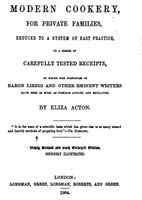Advertisement
Quince Paste
By Eliza Acton
Published 1845
If the full flavour of the quinces be desired, stew them sufficiently tender to press through a sieve, in the prepared juice, otherwise, in just water enough to about three parts cover them; when they are soft quite through lift them out, let them cool, and then pass them through a sieve; reduce them to a dry paste over a very clear fire, and stir them constantly; then weigh the fruit, and mix it with an equal proportion of pounded sugar, or sugar boiled to candy height (we find the effect nearly the same, whichever method be pursued), and stir the paste without intermission until it is again so dry as to quit the pan and adhere to the spoon in one large ball; press it into shallow pans or dishes; cut it, as soon as cold, into small squares, and should they seem to require it, dry them with a very gentle degree of heat, and when they are again cold store them in tin cases with well-dried foolscap paper between them: the paste may be moulded, when more convenient, and kept until it is wanted for table, in a very dry place. In France, where the fruit is admirably confected, the pâte de coigns, or quince paste, is somewhat less boiled than we have directed, and dried afterwards in the sun, or in an extremely gentle oven, in square tin frames, about an inch and a half deep, placed upon clean slates.

